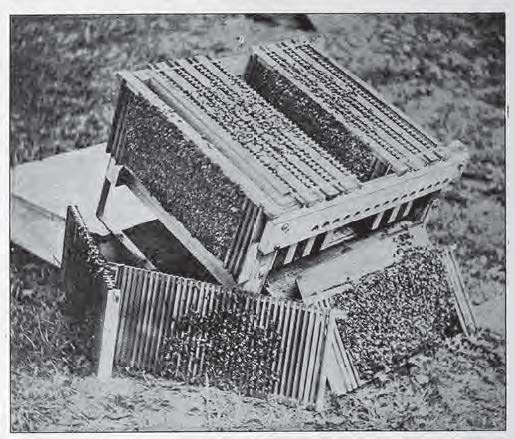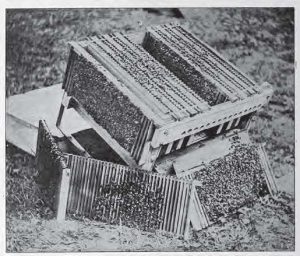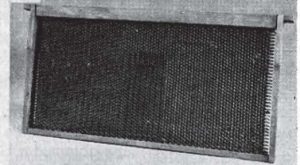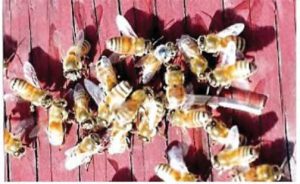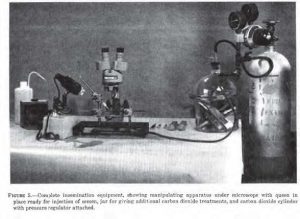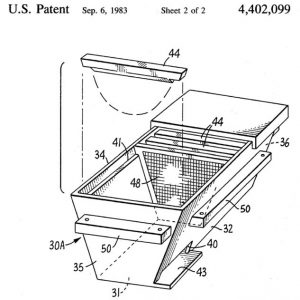By : Peter Borst
I know I will hear from some of you on this, but before you take pen in hand, give it a long thought: What new beekeeping developments have there been in the past 100 years? As I thought about it, I came up with just two. Only one of those applies to everyday beekeepers – the fume board for removing bees from honey supers. The other development I noted was instrumental insemination. What else was freshly developed for beekeepers?
1999, on the eve of the 21st century Troy Fore wrote the above in his publication, The Speedy Bee. Near as I can tell, nobody took him up on the challenge, so I will. There were literally hundreds of innovations; the patents applied for and issued are too numerous to count. Now, granted, not all of them had merit. In fact, one researcher suggests the way to determine the value of a particular patent is whether or not it got renewed. The first idea I wish to discuss was not patented at the time, most of us know it as the “Flow Hive.”
The Original Flow Hive
I almost burst out laughing when I first saw this. The writer not only describes the features of the original flow hive, but most of what he says applies to later versions: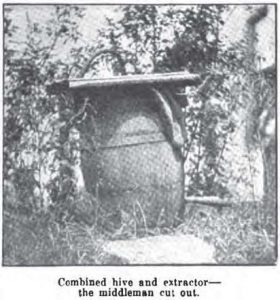
A beekeeper who claims to have found a way to get the honey and not the stings sent for me to look at his device. He told me how he intended to work it for all the honey he wanted, and leave some to sell; and as I found he had gotten hold of a new idea in beekeeping I took a photograph of his contrivance. I will say, however, that I do not advise its use except for those who are afraid of getting stung.
The device, as will be seen by the photograph, consists of a barrel set upon a stand high enough to allow a pail to be put under it to catch the honey as it runs out of the barrel. Thru the cover of the barrel runs a bent iron rod. To the bottom and along the sides of it, at intervals, are cross-pieces of iron with sharp edges to allow them to cut thru the comb inside the barrel and release the honey which flows to the bottom of the barrel thru a wire screen or strainer, and which is drawn off thru the faucet.
The iron rod, or pipe, as will be seen, is built so as to allow it to be turned like a crank, as it lakes considerable force to turn the knives in the comb after the bees have built around it and sealed it in with propolis. The inside fixtures may be easily understood from the following diagram, from which the device can be made if it is wanted.
The bees fasten their combs to the inside of the barrel, and the revolving knives reach far enough to leave a space of six inches between them and the sides of the barrel so as not to cut the comb loose and allow it to fall and drown the bees, but to shave off the capping’s and allow the honey to run down thru the strainer, where it is drawn off as needed.
The entrance for the bees being on the opposite side of the barrel from the faucet allows the operator to draw off the honey without disturbing them or he can close the entrance while he is taking the honey. It may be closed at night after the bees are all in, when there is little danger of being stung except by working the device at the wrong time or in the wrong way.
Since there is no patent on the invention as yet, anybody is at liberty to make one for himself, and use it without being disturbed except by the bees and he will find all danger of being stung is eliminated; and while he does not get comb honey it is a fi ne way to secure strained honey that he is satisfied is not adulterated – simply turn the crank a few times and open the faucet until the bucket is full; and if you get stung it is your own fault. – “Aesop.” (1916). An Agitator in the Hive. Gleanings in Bee Culture. 44:1
The Aspinwall Hive
Beekeepers, especially those attempting to produce comb honey in small wooden boxes, were vexed by the problem of bees refusing to work in the sections and swarming out instead:
L.A. Aspinwall goes at the problem by increasing the clustering space between the combs during swarming. To that end he has devised a hive consisting of a series of brood-frames, and during the swarming season a series of slatted wooden dummies or separators placed in alternation between the frames. These slatted dummies made up of quarter-inch vertical slats spaced a bee-space apart provide a clustering space between the brood-combs, thus relieving, the congestion that naturally arises because a large force of bees cannot be crowded into the small space between the combs such as are found in an ordinary hive.
The Aspinwall frames, instead of having one end-bar at each end, have a series of extra end bars bee-spaced apart that provide a clustering space at the ends of the frames as well as between them. The supers are constructed in much the same way as the brood-nest. The end-bars of the frames themselves being closed-end and close-fitting, constitute the ends of the hive proper, the frames simply resting on the cross cleats. The sides are closed up by means of wooden panels that hang like the frames on the frame-supports.
It has been claimed that there will be little or no clustering at the hive entrance, because the surplus bees will be clustered in the dummies between the frames; and as the dummies consist of a series of slats a bee-space apart, there can be no comb building. L.A. Aspinwall has tried out this principle, and it has worked so well in his hands that he thinks he has solved the problem of a non-swarming hive. But there have been some reports showing that it failed in the hands of others. The author believes the principle is good but too expensive for the average beekeeper. – Root, A.I. & E.R. (1917). The ABC and XYZ of Bee Culture
This idea was resurrected in the 1970s as the “Honey Master No- Swarm Cluster Frames”:
The results are now reported of a three-year study in Minnesota, USA, comparing the performance of colonies equipped with HM frames, and managed according to the manufacturer’s instructions, and of control colonies managed with conventional equipment and methods. During two Winters, winter survival and Spring build-up of HM colonies was not as good as of control colonies. In Summer HM colonies made preparations for swarming, and brood production was no higher than in control colonies.
It is pointed out that the management techniques recommended by the manufacturer are very similar to conventional methods, and it is concluded that the HM frames conferred no advantage. Package colony development was also studied; brood development was hindered by the presence of HM frames. At monthly Summer inspections, control colonies had a significantly larger brood area and significantly more frames of comb than HM colonies; after the major flow they averaged 20 lb surplus honey, compared with three lb in HM colonies. – Sugden, M.A., & Furgala, B. (1980). Honey Master no-swarm cluster frames. American Bee Journal, 120, 128-303.
Aluminum Honey Comb
The problem of comb breakage has challenged beekeepers from the beginning and enterprising inventors came up with this solution:
Mr. McDonald proposed the making of an indestructible comb that could not be affected by heat and that could be cleaned as easily as a kitchen utensil. He proposed a cellular strip of crimped metal to be woven together into hexagons with a rhombic base. He said that if a machine could be made to construct such a comb the problem was solved. Mr. Paxton being a practical mechanic, said he could construct such a machine. From the resulting experiments the Aluminum Honey Comb was born. Many leaders in apiculture consider this invention the greatest achievement in beekeeping since the beginning of this century. – Ratcliff. S.A. (1919). Aluminum Comb. Proceedings of the Texas Farmers’ Congress.
Three years ago it was my privilege to use some of the first combs put out by the Mc Donald company. While the bees used these combs, the cells were so deep that the bees would not take to them readily. The shallower combs used in 1920 were very readily accepted by the bees, and the better waxed and braced frames made in Texas in 1921 were accepted almost at once. In handling the large number of combs, I have noticed that the bees would accept those which were heavily waxed more readily than when only slightly so, and 1 believe that for ease in handling it would pay to have the frames better nailed.
I think that the aluminum honey comb is the greatest advance in scientific apiculture since the invention of the movable frame, hive. The fact is I think it so strongly that I shall mention them in a 5,000 word theme on “The Advanced Methods of Beekeeping,” that I am to write in connection with my University English. Later, when I get my M.A. degree, I expect to write my “Masters thesis” along this same line, and I expect to mention the aluminum honey combs in both of these written documents. – Stearns, M.C., (1921). Two Years with Aluminum Combs; in: The Beekeepers’ Item for November-December.
As one would expect, there was a great deal of skepticism aimed at such invasive meddling in the bee hive:
The problem of better combs is treated by Editor Root in February Gleanings, and H.H. Root has a valuable article on the same subject on page 79 of the same issue. This is an important thing and, as Mr. Root points but, many inventions and contraptions are always being put out to solve the problem. He warns beekeepers not to plunge too heavily into the purchase of these newer things until the test of time and experience has stamped them with approval. This is good advice. Beekeeping history is marked with gravestones of discarded paraphernalia. – LeStourgeon, E. G. (1922.) Gossip With Our Neighbors, in: The Beekeepers Item, February
Finally, the whole enterprise was utterly condemned:
We regard the aluminum comb as one of those “gadgets” which only the foolish amateur will play about with. It is a grand example of the evil habit of trying to complicate life (in the name of “progress”) which is so pernicious in all spheres of work. – Anonymous. (1938). Press Mirror. Bee World, 19:11
Bee boost
The discovery of “queen substance” and the role of pheromones in the hive led to all sorts of notions of how these chemical might be made to direct or control behavior in the hive:
In a recent issue of Speedy Bee, the editor, Mr. Troy Fore, asserted that there have been relatively few beekeeping innovations in the Twentieth Century (Fore, 1999). His thesis is that the great majority of beekeeping technologies, which we enjoy today, are merely refinements, in quality or scale, or both, of earlier, mainly Nineteenth Century inventions. His short list of truly Twentieth Century developments did not include the effort that has been expended on the study and synthesis of some of the natural honey bee pheromones. Here I wish to discuss the use of pheromones in beekeeping; specifically – Queen Mandibular Pheromone (QMP) and, to a lesser extent, the Nasonov pheromone (Blum, 1992).
We believe that both the QMP (BEE BOOST) and the Nasanov (SWARM CATCH) pheromones are very important tools for use in beekeeping. There is no question as to the effectiveness of the BEE BOOST in holding bees in queenless units. The SWARM CATCH lures, while not as unequivocally effective as the BEE BOOST strips, still have an overall positive value in attracting swarms into swarm traps. Because of the evident longevity of these products, we consider that the cost is negligible when compared with their importance. Pheromones are a very important addition to beekeeping technology in the twentieth century. It is safe to assume that their usefulness will continue into the future. – Pederson, John. (undated). http://www.pedersenapiaries.ca/ use_of_pheromones.html
The BEEBOOST® product, made from synthetic queen mandibular pheromone, is already used successfully by beekeepers and scientists to mimic the presence of the queen. SuperBoost® has also a lot of potential to be used to stimulate colony growth, honey production, and overwintering. Its use by beekeepers may have practical uses in the beekeeping industry. However, the question of potential adverse effects of the use of these pheromones to disrupt the social regulations of the colony should be also studied. — LeConte, Y. (2017). Beekeeping and Science in: Beekeeping–From Science to Practice, 2017 – Springer
Instrumental Insemination
Mr. Fore mentioned this as one of the few significant breakthroughs of the 20th Century. It was definitely touted as such and no doubt has greatly increased our understanding of honey bee genetics.
The art of the instrumental insemination has actually proceeded far enough that all of the queens utilized in the entire U.S. could easily be done completely by instrumental insemination rather than flight mating.
To explain: one person trained in instrumental insemination with someone else bringing him the virgins and drones for insemination purposes could easily inseminate 75 queens/day. Ten such persons then would be able to turn out 750 queens/day. And this would be done without the benefit or the need for the huge investment in nuclei and material that goes into natural mating of queens. More than that, it could be done in spite of the weather. Many times in this country, queen breeders in the spring of the year are badly held up in their work because cold, wet weather interferes with virgins’ flight and drones’ flight and mattings cannot be made, until a later time. All of this would be eliminated with instrumental insemination of queen bees. More than that, the ancestry of the queens and the drones would be absolutely and accurately known, instead of random mating which occurs now. When the queen fl ies and mates she may mate with drones from as far away as five to six miles, and really no one knows exactly what drone is utilized in the mating. — T. Ross, T. Dadant, G.H. Cale. (1976). Tradition and Progress: Dadant & Sons, Illinois. Apiacta
Yet, once again skeptics emerge. Suffice it to say, large scale Instrumental Insemination never really caught on:
Bee breeding is still in an embryonic stage. There are many reasons for this but again the major problem is a lack of knowledge of basic bee behavior. We have no good method of controlling breeding on a large scale except through the use of islands; this is too expensive to be practical. Artificial insemination, helpful as it is, is still a laboratory tool and useful only in the early development of a breeding program. Someday, when we have more knowledge about honey bee biology we may produce better bees. However, until that time colony management is most critical and the area where beekeepers can most profitably invest their time and effort. – R. Morse, U.S.A. (1971) Scientific Accomplishment in Commercial Beekeeping in the United States. Apiacta
As an aside, my friend Tom Glenn was able to make a decent living selling instrumentally inseminated queens.
Top Bar Hives
It might seem odd to include the “top bar hive” as an invention of the 20th century as it seems to hark back to an earlier time. The resurrected idea appears to originate from work done by Dr. Townsend from Guelph, Ontario:
The hive was tested on an extensive scale by Mr. Jim Nightingale, of Njoro, Kenya, and proved to be quite successful for Kenya conditions. With this hive it is possible to remove the frames which contain only honey. The major drawback, which restricts its use to stationary-type beekeeping, is that the combs will break away from the top bar quite readily. The combs must be suspended vertically at all times; if the bar is rotated so that the comb is horizontal, the weight of the comb may cause it to break from the bar. To harvest the honey and beeswax, remove the combs that contain fully capped honey but no pollen or brood. – Townsend, G. F. (1977). Transitional hives for use with the tropical African bee Apis mellifera adansonii. Apiacta; an international technical magazine of apicultural and economic information.
Unfortunately, even something as rudimentary as the top bar hive may require expensive materials that are out of reach to some communities.
Patents in Bee-Keeping
As I said, there are enough patents related to honey bees and beekeeping to keep one chuckling for many long Winter nights. This excerpt is from the American Bee Journal, dated May 19, 1904 but also quotes E.R. Root on the subject of patents.
Occasionally there arises one in the bee-keeping line who thinks he has some invention that is going to revolutionize the industry of bee culture. He therefore patents it. Perhaps in the majority of cases it is a new kind of bee-hive. His special hive will simply compel the bees to store lots of surplus honey! But it is mostly on paper, or “in his mind.” After making a careful examination of all the apiarian patents ever granted in this country, Editor E. R. Root gives this as the result of his investigation:
Nine-tenths – yes, I am safe in saying ninety-nine percent – of all patents relating to bee-culture have been issued to men – can hardly call them bee-keepers – who have had almost no practical knowledge of the general principles covering hive-construction and the general habits of bees. The great majority of these useless inventions, even if they would accomplish what was expected of them by the brilliant (?) geniuses that evolved them, would have absolutely no sale, for the simple reason that the dear public is not going to pay for something for which it has absolutely no need. Let me give a few illustrations of some of the wonderful (?) inventions.
One inventor got up a hiving-apparatus that consisted of cogwheels, shafting, chain-gearing, and elaborate frame-work, for dumping a swarm, after it has clustered, into a hive. The whole apparatus would cost a hundred times as much as any swarm is worth. And, just think of it! here was a man who had the temerity to pay out $100 for a patent covering something he supposed would have a demand! Was he after glory or money?
We certainly would not try to discourage real inventions, but how silly it is for one, who has had perhaps only a few months’ experience with bees, to think that he is able so to improve the hives and other fixtures of beedom as to revolutionize the business, and himself command wealth and fame! How very many devices have been patented that never were in sufficient demand to pay the cost of securing the patent. In the twenty years that we have been connected with bee-keeping interests, we can not recall a half-dozen apiarian inventions that ever paid the expense of having them patented. It’s discouraging to would-be inventors in this line, but it is history that is well worth heeding. — York, G. (1904). Patents in Bee-Keeping. American Bee Journal. 44:17
Can’t say that beekeepers were not warned! One hundred years ago they could read plainly in Root’s bible of beekeeping:
It might be interesting and perhaps enlightening to some would-be inventors to record here a list of the inventions that have died a natural death. Some of these at the time were heralded as revolutionary; they never “revolutionized,” but, on the contrary, sickened and died, as thousands of others had done. It is well that they did.
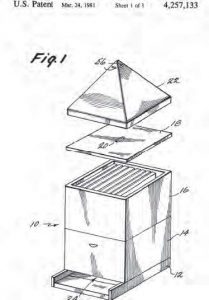
It is but fair to say to inventors that a patent or patents on any invention or improvement relating to bee-feeders, methods of wiring frames, or foundation-fasteners, are generally a waste of time, and can only lead to disappointment. There is a large list of patents in the Patent Office covering all forms of bee-feeders, not one of which is equal to any of the unpatented feeders described under the head of Feeders. In the same way it is a waste of time to try to invent a beehive, something new and better than those that are generally accepted by the fraternity at large. Every conceivable form of hive has been made the subject of a patent. With perhaps a dozen important exceptions there is hardly a patent on bee-fixtures that is worth the paper on which it is printed; and the beginner, at least, will be very wise if he accepts the standard hive and appliances which are described in this or any standard work on bees. It is true, patents will be granted on almost anything; but any one who is familiar with patent claims knows that they can be and usually are so loosely drawn that they are worthless. The poor inventor supposes that because he has been granted a government parchment a fortune awaits him. But he is doomed to disappointment as sure as fate. – Root, A.I. & E.R. (1917). Inventions Relating to Bee Culture. The ABC and XYZ of Bee Culture. If there’s a lesson to be learned, it’s that Hope Springs Eternal. Every generation has the notion that the Old World exists primarily to be overturned.






